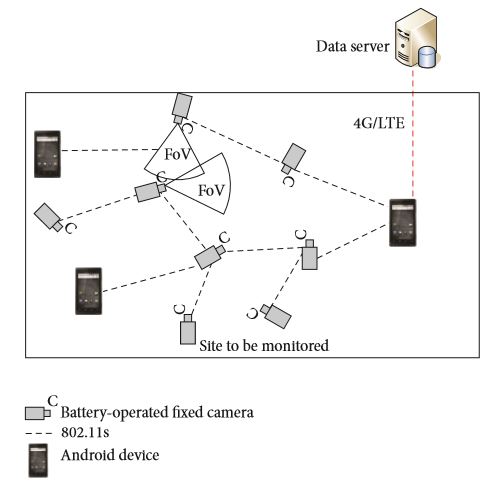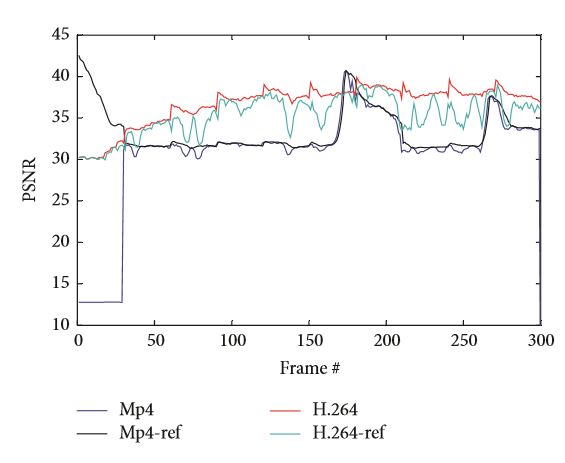ABSTRACT
With the increased use of smartphones, Wireless Multimedia Sensor Networks (WMSNs) will have opportunities to deploy such devices in several contexts for data collection and processing. While smartphones come with richer resources and can do complex processing, their battery is still limited. Background subtraction (BS) and compression techniques are common data reduction schemes, which have been used for camera sensors to reduce energy consumption in WMSNs.
In this paper, we investigate the performance of various BS algorithms and compression techniques in terms of computation and communication energy, time, and quality. We have picked five different BS algorithms and two compression techniques and implemented the min an Android platform. Considering the fact that these BS algorithms will be run within the context of WMSNs where the data is subject to packet losses and errors, we also investigated the performance in terms of packet loss ratio in the network under various packet sizes.
The experiment results indicated that the most energy efficient BS algorithm could also provide the best quality in terms of the foreground detected. The results also indicate that data reduction techniques including BS algorithms and compression techniques can provide significant energy savings in terms of transmission energy costs.
RELATED WORK
Several performance evaluation studies have been published to examine the weakness and strengths of BS algorithms. In a comparative evaluation of classical approaches has been conducted on background subtraction algorithms for exposing static foreground objects. The previous solutions have been categorized into several classes. Then, representative solutions have been compared using both quantitative and qualitative metrics. The paper concludes that sub sampling based solutions give the best results at the expense of a low computational cost for general purpose static object detection.
The authors in have evaluated BS algorithms for a wide group of challenges in video surveillance. Nine different object segmentation algorithms are performed for surveillance settings where each of them covers different challenge such as gradual illumination changes, dynamic background, and shadows. The effect of the used post processing algorithms on several popular BS algorithms has been examined in.
Their comparison is conducted with a varied set of 7 outdoor and 6 indoor video sequences for different threshold parameters. In the authors provided a comparative study of several BS algorithms in terms of robustness,memory requirement, and computational efficiency. In several background subtraction algorithms are applied to the images with the ground truth in order to count the number of cars.
BACKGROUND SUBTRACTION FOR ANDROID DEVICES
In this paper, we still consider a scenario in the context of WMSNs but battery-operated Android devices are also considered as part of this network. Such a device (e.g., an Android phone) can act as a relay to transmit multimedia data from cameras using its WiFi capability assuming that the WMSN runs a protocol stack based on IEEE802.11s which is the new mesh networking standard. Another possibility is to employ the Android devices as a data collect or that relays the data to a remote station using 4G/LTE connections. A sample system architecture is shown in Figure2.

Figure 2: A WMSN with Android devices involved
When transmitting multimedia data over wireless channels in WMSNs, transmitted data is subject to packet losses or errors due to channel impairments. In particular, wireless link quality fluctuates dramatically over time due to the distance between nodes, multi path propagation, and interference. The problems can be compounded with the effects from the environments (e.g., line of sight, obstacles).
These problems may affect the quality of the received multimedia data which makes the selection of BS algorithm a more challenging task. Therefore, we will test the quality of the BS algorithms under various network conditions. As will be elaborated in the next section, we will consider different packet loss ratios and packet sizes when sending video data to the Android devices as seen in Figure 3 which makes the selection of BS algorithm a more challenging task.

Figure 3: An example of a distorted image
EXPERIMENT SETUP
To examine the performance of the data reduction techniques, we have conducted a group of simulation experiments in Eclipse IDE for Android including Java, C++, JNI and Open CV libraries. Assuming that an HTC Inspire 4G Android phone with 1GHz Snapdragon processor and 4GB memory on-board is part of the WMSN architecture, video data is processed on this phone.
Once the phone obtains the video, BS algorithms are executed on this video in order to find the foreground of the considered frames. In this part of the experiments, we assumed that only one source generates multimedia data and this data is transmitted to the smart phone. We have not considered any distributed collaboration between the existing nodes and the smart phone.
PERFORMANCE ANALYSIS
Compression Techniques

Figure 5: Multimedia quality comparison of the compression techniques in terms of PSNR
Figure 5 presents PSNR values of the received video frames which are decoded in MPEG-4 and H.264, respectively. MPEG-4-ref or H.264-ref PSNR values present reference PSNR values of the coded and then decoded videos without transmission errors/losses in relation to the uncoded raw video source.
CONCLUSION
This paper presented a comparative evaluation of a representative group of data reduction techniques including background subtraction algorithms and compression techniques for Android devices used in WMSNs. These techniques are compared based on their energy requirements for computation and communication as well as their capability of correctly detecting objects on both original and distorted frames. Since the frames in the database come with ground truth, precision, recall, and -measure are used to compare the relative accuracy of the algorithms.
The study investigates the energy and time requirement of five background subtraction (BS) algorithms for Android-based smart phones in WMSNs. Additionally, two well-known compression algorithms are examined in terms of energy and storage for the same Android platform. Firstly, the existing approaches have been analyzed in terms of energy, delay, and storage in an Android application. Then, the algorithms have been studied in terms of several metrics including recall, precision, and -measure. Additionally, the impact of the packet size and frame error rate on performance of BS algorithms is evaluated with respect to wireless transmission errors. All performance results of BS are given to understand their suitability for wireless communication for video data.
The performance results of BS techniques showed that, compared to the other algorithms, AMF has been the best in terms of all the metrics compared and thus fits the Android applications the best. AMF has the least energy consumption and it is the fastest algorithm. AMF is also better in terms of -measure and precision for non distorted video data.The simulation results also show that the EGB, AMF, RGA, and AGM algorithms are also capable of identifying region of interest part of the distorted frames in loss y networks.
However, increased frame error rate results in poorer performance in terms of -measure. Additionally, packet length does not have an impact on performance results for varying frame error rates. The computational evaluation results of compression techniques showed that the encoding energy consumption of MPEG-4 at the source is less than that of H.264 one at the expense of storage and multimedia quality over WMSN.The performance of MPEG-4 in terms of transmission energy also out performs H.264 for a single hop multi media transmission over WMSN.
Source: Bahcesehir University
Authors: Pinar Sarisaray-Boluk | Kem Ala Kkaya
>> Wireless Sensor Networks Projects Abstract for Final Year Students
>> Simple Java Projects with Source Code Free Download and Documentation